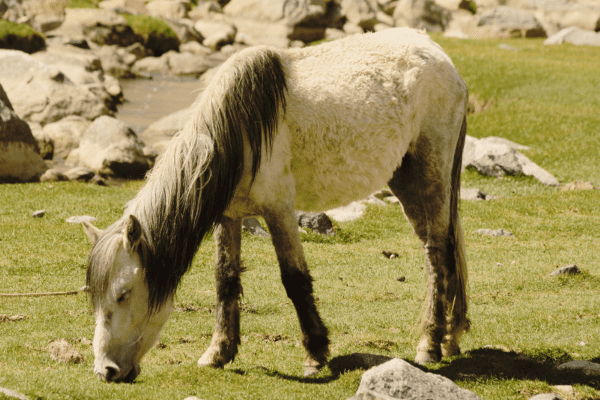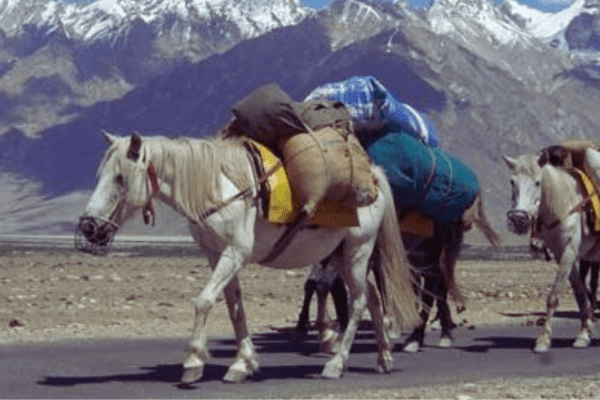The Zanskari horse, often referred to as the Zaniskari, is a distinct breed of small, robust equines that originate from the rugged and lofty landscapes of Ladakh in northern India. This breed, which takes its name from the serene Zanskar region within Kargil district, stands as a testament to the area’s natural and cultural richness.
Currently, the Zanskari horse is facing a critical situation with their population numbers dwindling to a mere few hundred. This alarming scenario has catalyzed the initiation of a focused conservation effort in Padum, located in the Zanskar valley of Kargil district, Ladakh. The primary goal of this program is to safeguard the survival of this unique breed, ensuring that it continues to thrive and remain a vital part of Ladakh’s heritage.
History:
Tracing the history of the Zanskari horse reveals an intricate interweave of ecological adaptation, cultural significance, and modern challenges. Native to Ladakh in India’s high altitude terrains, this breed has experienced both periods of flourishing as well as critical endangerment over its lifetime.
The Flourishing Era (Pre-1977)
Prior to 1977, Zanskari horses were an increasingly common sight across Ladakh’s mountainous terrain and estimates pegged their numbers between 15,000 to 20,000, signifying an active and thriving population.
Initial Decline (Post-1977)
As the years passed post-1977, their numbers started dwindling slowly due to various contributing factors.
Cross-Breeding Impact: One of the primary contributors to Zanskari horse’s decline has been their inexact crossbreeding with other breeds, which dilutes their genetic purity.
Habitat Shifts: With the expansion of roads and mechanization in Ladakh, traditional grazing patterns were disturbed, further impacting its population.
FAO Assessment (2007)
Status Designation: In 2007, the Food and Agriculture Organization (FAO) assessed Zanskari horses as “not at risk”, an assessment which may have underestimated their vulnerability.
Continued Population Decline
(2006): Despite declining numbers, a 2006 study discovered no genetic bottleneck. This suggests a resilient genetic diversity within the breed.
Sharp Decline (2013-2022): By 2013, the population had decreased to approximately 9,700 animals. As time progressed, however, its decline escalated until by 2022 the Domestic Animal Diversity Information System (DAD-IS) reported only 346 individuals left and labeled them “at Risk/Critical Maintained”.
Genetic Studies and Relations
2007 Genetic Analysis: According to research done in 2007, it was discovered that the Zanskari breed shares close genetic ties with Manipuri, Spiti, and Bhutia breeds and distantly with Marwari breed.
2014 Study Findings: In 2014, further research reaffirmed these connections between Zanskaris and Spitis breeds – in particular.
Conservation Efforts:
Breeding Program in Padum: Due to an alarming decrease in their numbers, Jammu and Kashmir’s Animal Husbandry Department initiated a conservation and breeding program in Padum, Zanskar in order to safeguard genetic integrity and ensure survival of this unique breed.
Cultural and Ecological Importance
Zanskari Horse’s Significance Extends Beyond Figures: The significance of Zanskari horses goes well beyond mere population statistics; this breed is interwoven into Ladakh’s cultural fabric, serving as a powerful symbol for its history, traditions, and ecological balance.
Looking Ahead
Future Prospects and Challenges: Ongoing conservation efforts combined with increased awareness present a ray of hope for the Zanskari horse. Though its future may pose formidable obstacles, the commitment shown towards saving this unique breed speaks to a larger narrative of ecological preservation as well as cultural preservation.
Overall, the Zanskari horse’s history serves as an important reminder of how nature and humanity must coexist peacefully and sustainably. Furthermore, it emphasizes the significance of sustainable practices and conservation strategies in maintaining not just breeds but also regions’ unique heritage and biodiversity.

Characteristics:
The Zanskari horse, native to Ladakh’s high alpine landscapes, is revered for its robust yet well-proportioned build; an adaptation perfectly tailored for Ladakh’s hypoxic environment.
Stature and Build:
Hardy Zanskari horses typically stand from 120 to 140 centimeters (12-14 hands), boasting compact yet muscular forms due to the rugged terrain they inhabit. These sturdy forms may be seen grazing across different regions around the world.
Measured Proportions: The breed typically displays a thoracic circumference spanning 140 to 150 centimeters (55 to 60 inches), indicative of its strong and expansive chest. Their body length typically falls within 95-115 centimeters (38-45 inches), further reinforcing their well-balanced and resilient structure.
Adaptation to High-Altitude Living:
Zanskari Horses Are Highly Efficient at Working in Hypoxic Conditions: Zanskari horses have proven themselves remarkably efficient at operating in Ladakh’s high altitude environments, where oxygen levels tend to drop drastically. Their physiological traits enable them to complete laborious tasks where other breeds might struggle.
Coat Characteristics:
Predominant Grey Hue: For Zanskari horses, grey is often their coat color of choice – an aesthetic trait as well as natural camouflage within their native terrain.
Diverse Color Palette: While grey dominates, Zanskaris come in various shades such as bay, brown, black and chestnut; this wide spectrum of colors adds allure and individuality.
The Zanskari horse, with its distinct physical traits and remarkable adaption to its environment, stands as an embodiment of nature’s resilience and versatility.
Not only are these horses physically strong; they also represent life at high altitudes where native species flourish under extreme environmental conditions – further cementing its symbolic role. As such, its presence serves as both practical relevance as well as living evidence of life harmony within Ladakh’s mountainous ecosystems.
Temperament and Trainability:
Zanskari horses are beloved companions. Easy to train and immensely loyal, their gentle temperament is ideal for riding by novice equestrians alike.
Their intelligence allows them to remember paths and directions more readily, helping them navigate mountainous landscapes safely.

Uses and Roles:
Zanskari horses have long been utilized for transporting goods and people across difficult terrain. Additionally, these hardy creatures can also be employed in agriculture and herding duties, with their endurance making them popular choice in endurance riding competitions.
Conservation Efforts:
The Zanskari horse is currently facing threats from crossbreeding and the dwindling need for traditional transportation methods. Conservation efforts are underway to preserve this unique breed.
Breeding programs and awareness campaigns aim to maintain the purity of the breed and promote its significance in the cultural fabric of Zanskar.

